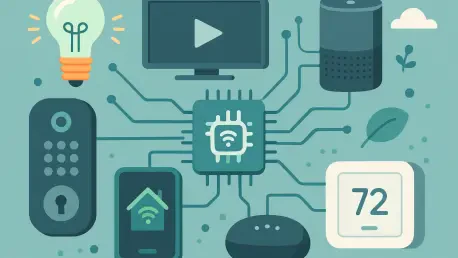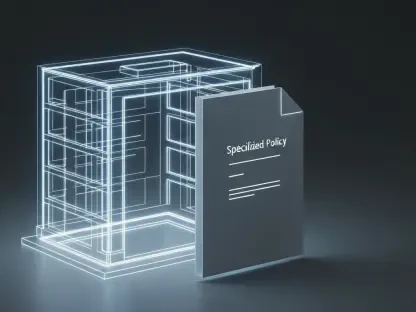Imagine a future where every smart device in a home communicates effortlessly, regardless of brand or platform, creating a seamless network that eliminates the frustration of dropped connections and incompatible systems. This is the vision promised by Thread 1.4, the latest update to a networking standard designed to unify smart home ecosystems. However, the reality for many households is far from this ideal, as the staggered rollout of this critical upgrade across various platforms has left numerous homes grappling with fragmented networks. While some tech giants have begun integrating the new standard, others remain in testing or planning phases, delaying the dream of true cross-brand harmony. This slow deployment means that many users might not experience a fully unified smart home until as late as 2026, highlighting a significant gap between expectation and execution in the rapidly evolving smart home industry.
1. Understanding the Promise and Challenges of Thread 1.4
The anticipation surrounding Thread 1.4 centers on its potential to revolutionize smart home connectivity by merging disparate mini-meshes into a single, robust network. Touted as a game-changer, this update aims to address long-standing issues of device incompatibility and network fragmentation that plague mixed-brand environments. However, the current rollout paints a different picture, with many homes still managing parallel Thread networks that struggle to communicate effectively. Apple’s integration of Thread 1.4 in tvOS 26 marks a step forward, yet other major ecosystems are lagging, either testing or scheduling updates at their own pace. This uneven adoption suggests that full interoperability across brands could remain elusive for months, if not longer, leaving users to navigate a patchwork of connectivity solutions in the interim.
Beyond the immediate hurdles, the timeline for achieving smart home unity adds another layer of complexity to the situation. The Thread Group has set a definitive marker, stating that Thread 1.4 will become the sole Border Router certification by January 1, 2026. Until that point, fragmentation is likely to persist, especially in households that rely on a mix of devices from different manufacturers. This delay underscores a broader challenge within the industry: synchronizing updates across diverse platforms to deliver a cohesive user experience. As Matter 1.4 concurrently introduces reliability and setup improvements, the convergence of these standards at the networking level remains critical for eliminating daily operational hiccups faced by many smart home enthusiasts.
2. Key Enhancements Brought by Thread 1.4
Thread 1.4 introduces a suite of features aimed at enhancing the reliability and usability of smart home networks, particularly for those using mesh configurations. Among the standout improvements is credential sharing, a secure method allowing a Thread 1.4 Border Router to grant temporary admin access for device integration without exposing permanent keys, thus preventing the creation of new, isolated meshes. Additionally, better IP connectivity through IPv6 and DHCPv6 Prefix Delegation ensures global addressing for devices, while NAT64/DNS64 support streamlines interoperability for secure remote access. Enhanced diagnostics, Thread-over-infrastructure for larger homes, secure commissioning via TCAT, and mesh robustness tweaks further solidify this update as a foundational fix for persistent networking challenges.
Industry perception of Thread 1.4 aligns with its technical advancements, as media and developers recognize it as a pivotal release that standardizes critical functions like credential sharing and network manageability. These changes are seen as steps toward eliminating vendor-specific network islands, fostering a unified mesh environment where devices operate seamlessly regardless of origin. Beyond mere functionality, the update addresses pain points such as latency and routing inefficiencies, promising a smoother experience in busy households. As these enhancements roll out, they lay the groundwork for a future where smart home systems are not just interconnected but also intuitive and reliable, setting a new benchmark for what users can expect from their connected devices.
3. Why Fragmentation Persists in Smart Homes
Despite the availability of Thread 1.4 specifications and an open certification program, the pace of adoption varies significantly across major tech ecosystems, contributing to ongoing network fragmentation. Apple has taken an early lead by embedding Thread 1.4 support in tvOS 26, enabling smoother integration within its ecosystem. However, other key players like Google, Amazon, and Samsung are at different stages of testing and implementation, creating a disjointed landscape where not all devices can yet communicate on the same level. This discrepancy means that many households with mixed-brand setups continue to operate multiple, incompatible Thread networks, a situation that undermines the very purpose of the update.
The certification timeline established by the Thread Group further complicates the path to unity, as Thread 1.4 will not be the exclusive Border Router standard until early 2026. Until this transition completes, users can expect persistent fragmentation, particularly in environments that blend hardware from various vendors. Meanwhile, Matter 1.4 offers complementary improvements in setup and reliability, yet the full benefits hinge on aligning the underlying networking layers across platforms. Industry leaders anticipate that the focus over the coming months will be on bolstering performance, with broader advantages emerging only as Thread 1.4 becomes the norm, signaling a gradual but necessary shift toward a more cohesive smart home experience.
4. Identifying Symptoms of a Fragmented Thread Network
For households that integrate devices from multiple brands, the signs of a fragmented Thread network are often frustratingly apparent and disrupt daily functionality. Devices may frequently alternate between being reachable and unreachable, causing automations to fail or delay unexpectedly. Additionally, smart home apps might display several distinct Thread networks instead of a unified one, or they may refuse to connect to the preferred network, complicating device management. Such issues highlight the practical challenges users face when the promise of seamless connectivity remains unfulfilled due to inconsistent update rollouts across ecosystems.
Another common symptom emerges when introducing a new Border Router, which often results in the creation of a separate network rather than integrating with an existing one, further fragmenting the system. This not only confuses the setup process but also impacts device performance, as battery life can drain faster due to inconsistent connections with parent routers. These persistent problems underscore the real-world impact of delayed Thread 1.4 adoption, leaving many users to contend with unreliable smart home setups while awaiting broader compatibility. Recognizing these symptoms is the first step toward mitigating their effects through strategic device management and update monitoring.
5. Cybersecurity Advantages of Thread 1.4
Thread 1.4 brings significant cybersecurity benefits by reducing vulnerabilities inherent in fragmented smart home networks, addressing risks that often go unnoticed by users. With fewer separate meshes, there are reduced opportunities for outdated firmware or old credentials to persist, minimizing potential entry points for threats. Predictable routing also enhances network monitoring capabilities, making it easier to detect anomalies that could indicate malicious activity. These improvements create a more secure foundation, ensuring that smart homes are not just connected but also protected against evolving digital threats in an increasingly online world.
Moreover, the update’s focus on proper IP implementation through DHCPv6-PD and NAT64/DNS64, managed by Border Routers, eliminates the need for insecure workarounds often used for remote access, thus lowering the risk of exploitable misconfigurations. Global IPv6 addressing, while beneficial, emphasizes the importance of robust firewalling and regular updates to Border Routers and controller apps, which serve as critical security gateways. As smart homes become more integrated with external services, maintaining these security practices becomes essential to safeguard against breaches, highlighting how Thread 1.4 not only improves connectivity but also fortifies the digital perimeter of modern households.
6. Practical Steps to Prepare for Thread 1.4 Adoption
As the industry moves toward widespread Thread 1.4 implementation, there are actionable steps users can take to ease the transition and minimize current network fragmentation. First, keeping Border Routers and controllers updated is crucial; for those in Apple’s ecosystem, monitoring for tvOS 26 is key, while enabling automatic updates on other devices ensures access to Thread 1.4 features as soon as they roll out. Selecting a primary Thread network and adding new devices through a single controller—whether it’s Home, Alexa, or Google Home—helps avoid spawning additional meshes during this interim period, maintaining a semblance of order amidst the staggered updates.
Additionally, strategic hub installation and hardware choices can make a significant difference; avoid adding new Border Routers without confirmed Thread 1.4 support or a clear upgrade path, and integrate them into existing networks when possible. Prioritizing 1.4-compatible devices by checking release notes or vendor statements, alongside bolstering security through updated admin credentials and multifactor authentication, further prepares systems for the update. For late-year shoppers, seeking explicit Thread 1.4 support or beta programs in devices from major brands, as well as firmware notes indicating stack updates, offers a head start. These steps collectively pave the way for a smoother shift to a unified network environment.
7. Looking Ahead to a Unified Smart Home Future
Reflecting on the journey, the rollout of Thread 1.4 represented a beacon of hope for ending the chaos of multi-mesh smart home networks, offering tools like credential sharing and enhanced diagnostics to bridge connectivity gaps. Despite the promise, varying adoption speeds across platforms meant that many households faced prolonged fragmentation, grappling with inconsistent device interactions and security concerns throughout the transition period. The industry’s staggered approach to updates revealed the complexities of aligning diverse ecosystems under a single standard, a challenge that persisted well into the planned certification shift.
Moving forward, the focus should center on actionable progress, such as consistently updating hubs and onboarding devices through a unified controller to minimize network splits. Prioritizing hardware with explicit Thread 1.4 compatibility remains a practical strategy for users aiming to future-proof their setups. As the smart home landscape evolves, staying informed about vendor roadmaps and maintaining robust security measures will be critical to harnessing the full potential of a faster, more reliable network, ensuring that the vision of seamless connectivity becomes a tangible reality for all.









